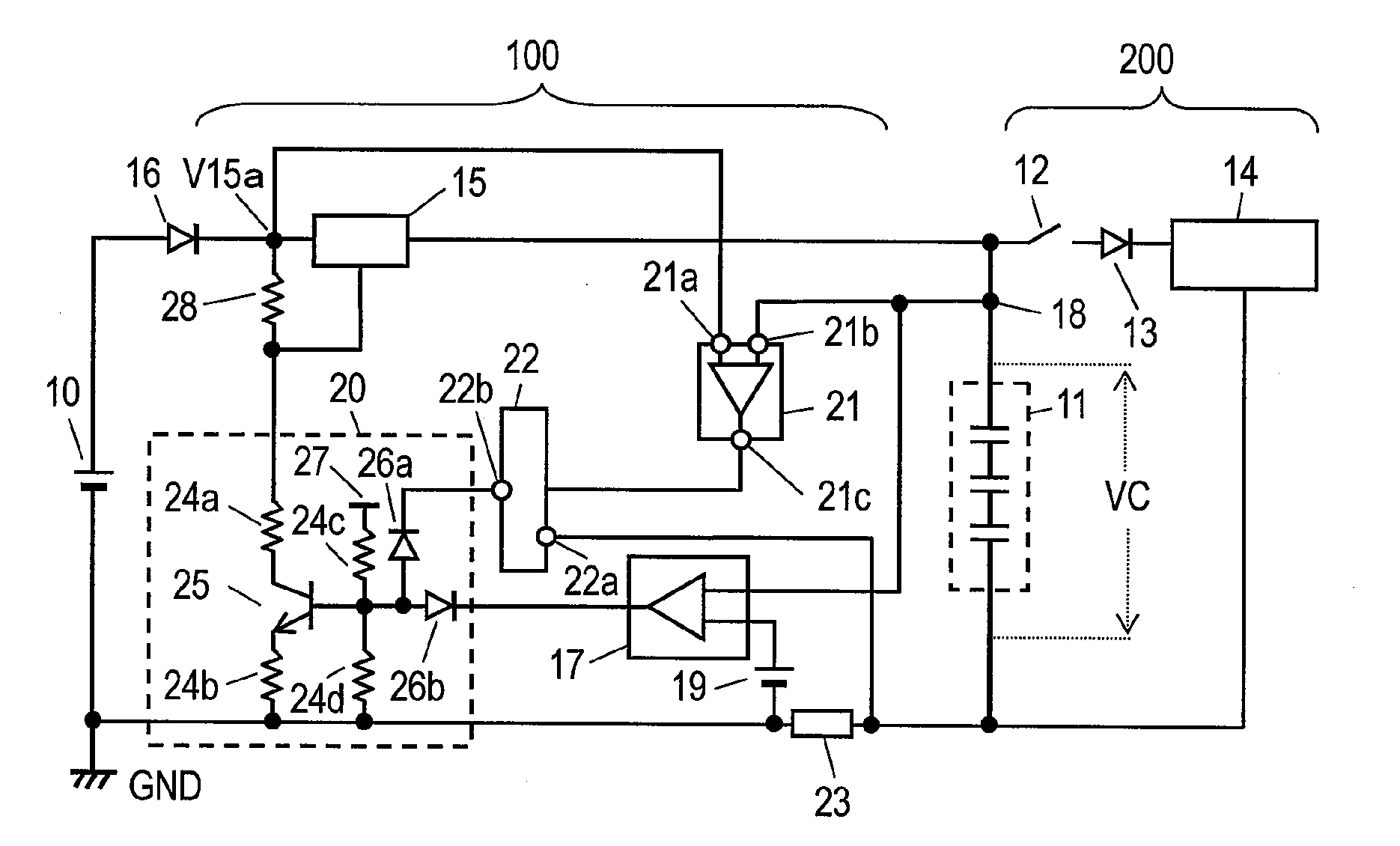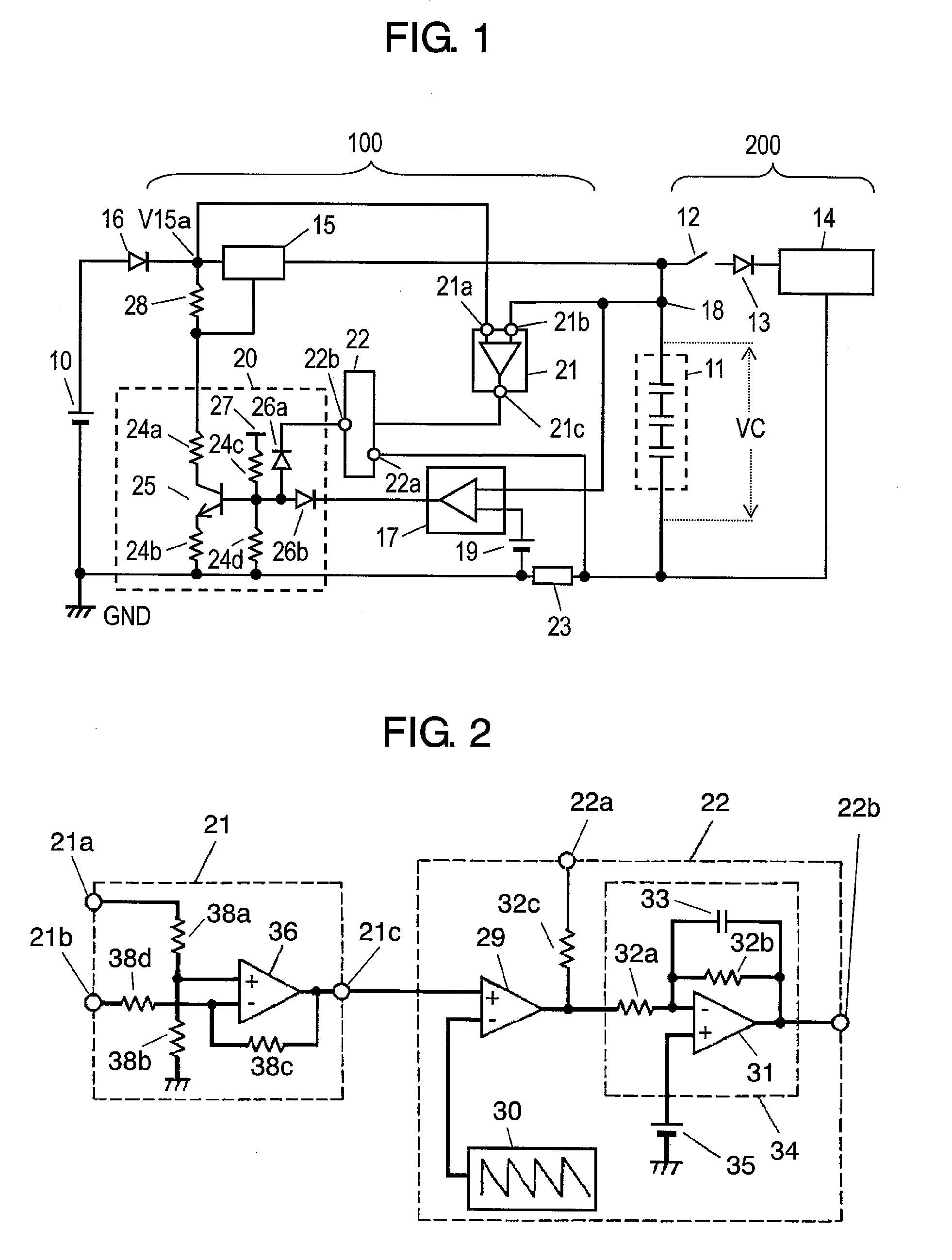Charging apparatus
- Summary
- Abstract
- Description
- Claims
- Application Information
AI Technical Summary
Benefits of technology
Problems solved by technology
Method used
Image
Examples
first embodiment
[0061]FIGS. 1 to 3C concern a first embodiment of the present invention.
[0062]FIG. 1 is a block circuit diagram of a charging apparatus. FIG. 2 is a circuit diagram of a voltage detecting portion and an integrator of the charging apparatus. FIG. 3A shows change over time in charging current of a capacitor and voltage generated in the capacitor. FIG. 3B shows change over time in loss power of a charging element. FIG. 3C shows change over time in internal temperature and surface temperature of the charging element.
[0063]In FIG. 1, DC (direct current) power supply 10 and capacitor 11 are connected to charging apparatus 100. DC power supply 10 supplies charging apparatus 100 with electric power, and electric charge is accumulated in capacitor 11 by electric power of DC power supply 10.
[0064]Capacitor 11 is constructed of an electric double layer capacitor. Consequently, not only rapid charging is enabled but also large electric power can be discharged for the braking of a vehicle in an ...
second embodiment
[0087]FIGS. 4 to 6C show a charging apparatus according to a second embodiment of the present invention. FIG. 5 is a circuit diagram of a voltage detecting portion, a power switching portion and an integrator of the charging apparatus. FIGS. 6A, 6B and 6C show change over time of the charging apparatus during a charging operation. FIG. 6A shows change over time in the charging current and capacitor voltage of the capacitor, FIG. 6B shows change over time in loss power of the charging element and FIG. 6C shows change over time in the internal temperature and surface temperature of the charging element.
[0088]In FIGS. 4 and 5, the same reference numerals designate the same components as in FIGS. 1 and 2.
[0089]The second embodiment is different from the first embodiment in that power switching portion 37 is connected between terminal 21c of voltage detecting portion 21 and integrator 22.
[0090]As shown in FIG. 5, the second embodiment is provided with power switching portion 37 constitut...
third embodiment
[0106]FIGS. 7 to 8C show a charging apparatus according to a third embodiment of the present invention.
[0107]FIG. 7 is a block circuit diagram of the charging apparatus. FIG. 8A shows change over time in the capacitor charging current and capacitor voltage, FIG. 8B shows change over time in the loss power of the charging element, and FIG. 8C shows change over time in the internal temperature and surface temperature of the charging element.
[0108]In FIG. 7, like reference numerals denotes the same components as in FIG. 1. The third embodiment shown in FIG. 7 is provided with current limiting portion 40 and diode 41 in addition to the structure described in the first embodiment. For example, current limiting portion 40 is constructed of a differential amplifier, and a voltage of current detecting portion 23 and reference voltage 19 are provided to each of two inputs of current limiting portion 40 separately. An output terminal of current limiting portion 40 is connected to control synt...
PUM
 Login to View More
Login to View More Abstract
Description
Claims
Application Information
 Login to View More
Login to View More - R&D
- Intellectual Property
- Life Sciences
- Materials
- Tech Scout
- Unparalleled Data Quality
- Higher Quality Content
- 60% Fewer Hallucinations
Browse by: Latest US Patents, China's latest patents, Technical Efficacy Thesaurus, Application Domain, Technology Topic, Popular Technical Reports.
© 2025 PatSnap. All rights reserved.Legal|Privacy policy|Modern Slavery Act Transparency Statement|Sitemap|About US| Contact US: help@patsnap.com



